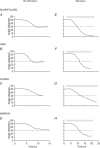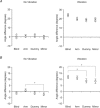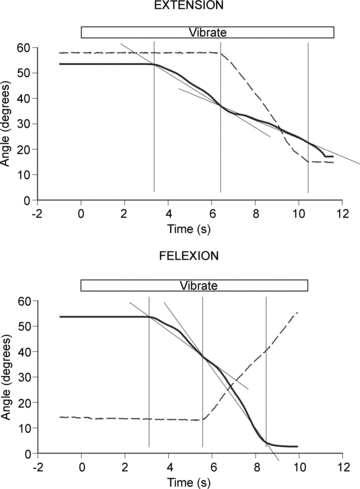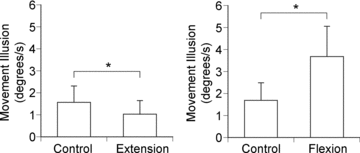The illusion of changed position and movement from vibrating one arm is altered by vision or movement of the other arm
- PMID: 20547672
- PMCID: PMC2956899
- DOI: 10.1113/jphysiol.2010.192336
The illusion of changed position and movement from vibrating one arm is altered by vision or movement of the other arm
Abstract
Experiments were carried out on blindfolded human subjects to study the contribution of proprioceptive inputs from both arms in a forearm position matching task. Blindfolded matching accuracy was compared with accuracy when the subject could see their indicator (matching) arm, when they used a dummy arm for matching, and when they looked at a mirror image of the matching arm. The position of the mirror had been arranged so that the image of the indicator arm coincided with the position of the reference arm. None of these conditions significantly altered the matching errors. When reference elbow flexors were vibrated at 70-80 Hz, the illusion of extension of the vibrated arm reported by blindfolded subjects was significantly reduced by vision of the mirror image of the indicator arm or when using the dummy arm. It was concluded that visual information about the position of the indicator arm, or the apparent position of the reference arm, could reduce the size of the kinaesthetic illusion from vibration, but not abolish it. In a second experiment, subjects indicated, by tracking with their vibrated arm, the illusion of forearm extension evoked by elbow flexor vibration. It was found that the perceived speed of extension could be reduced by moving the indicator into extension and increased by moving it into flexion. These experiments demonstrate the importance for the matching process of the input provided by the indicator arm. Such a conclusion may help to explain some apparent discrepancies between observations made on position sense using one-arm and two-arm tasks. More broadly, this paper provides support for the idea that aspects of proprioceptive inputs from both arms are processed conjointly, as part of a strategy for use of the two hands as a single instrument in certain skilled tasks.
Figures





Similar articles
-
Interaction between vibration-evoked proprioceptive illusions and mirror-evoked visual illusions in an arm-matching task.Exp Brain Res. 2012 Dec;223(4):541-51. doi: 10.1007/s00221-012-3281-7. Epub 2012 Oct 2. Exp Brain Res. 2012. PMID: 23111431
-
Proprioceptive illusions created by vibration of one arm are altered by vibrating the other arm.Exp Brain Res. 2014 Jul;232(7):2197-206. doi: 10.1007/s00221-014-3911-3. Epub 2014 Mar 27. Exp Brain Res. 2014. PMID: 24671653
-
Proprioceptive Interaction between the Two Arms in a Single-Arm Pointing Task.PLoS One. 2015 Aug 28;10(8):e0137031. doi: 10.1371/journal.pone.0137031. eCollection 2015. PLoS One. 2015. PMID: 26317518 Free PMC article.
-
Kinesthetic Senses.Compr Physiol. 2018 Jun 18;8(3):1157-1183. doi: 10.1002/cphy.c170036. Compr Physiol. 2018. PMID: 29978899 Review.
-
Measuring position sense.Exp Physiol. 2024 Nov 22. doi: 10.1113/EP092190. Online ahead of print. Exp Physiol. 2024. PMID: 39576257 Review.
Cited by
-
The effects of periodic and noisy tendon vibration on a kinesthetic targeting task.Exp Brain Res. 2024 Jan;242(1):59-66. doi: 10.1007/s00221-023-06727-1. Epub 2023 Nov 13. Exp Brain Res. 2024. PMID: 37955706
-
Limb position sense, proprioceptive drift and muscle thixotropy at the human elbow joint.J Physiol. 2014 Jun 15;592(12):2679-94. doi: 10.1113/jphysiol.2013.269365. Epub 2014 Mar 24. J Physiol. 2014. PMID: 24665096 Free PMC article.
-
Perception of gait motion during multiple lower-limb vibrations in young healthy individuals: a pilot study.Exp Brain Res. 2021 Nov;239(11):3267-3276. doi: 10.1007/s00221-021-06199-1. Epub 2021 Aug 31. Exp Brain Res. 2021. PMID: 34463827
-
Interaction between vibration-evoked proprioceptive illusions and mirror-evoked visual illusions in an arm-matching task.Exp Brain Res. 2012 Dec;223(4):541-51. doi: 10.1007/s00221-012-3281-7. Epub 2012 Oct 2. Exp Brain Res. 2012. PMID: 23111431
-
Position sense at the human forearm after conditioning elbow muscles with isometric contractions.Exp Brain Res. 2015 Sep;233(9):2635-43. doi: 10.1007/s00221-015-4334-5. Epub 2015 Jun 6. Exp Brain Res. 2015. PMID: 26048159
References
Publication types
MeSH terms
LinkOut - more resources
Full Text Sources
Medical

